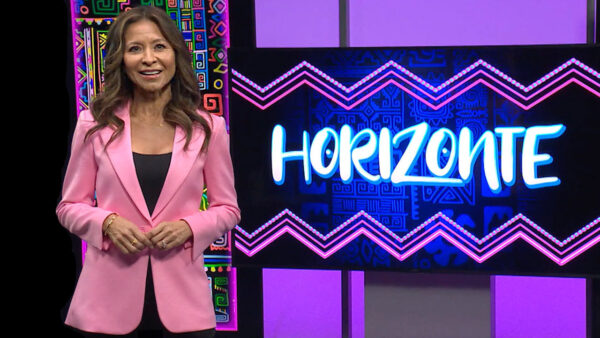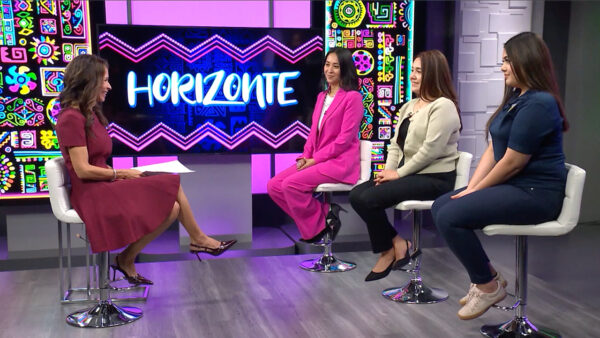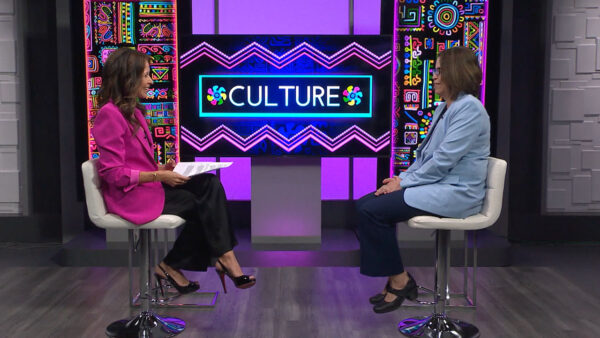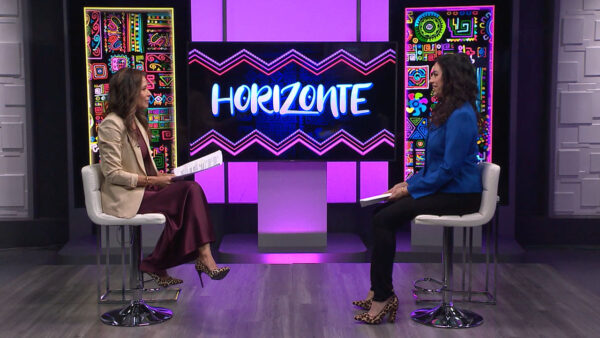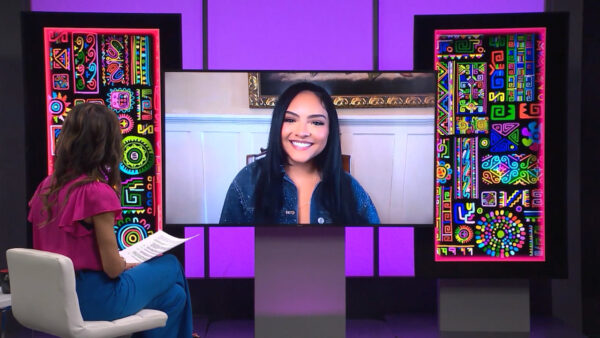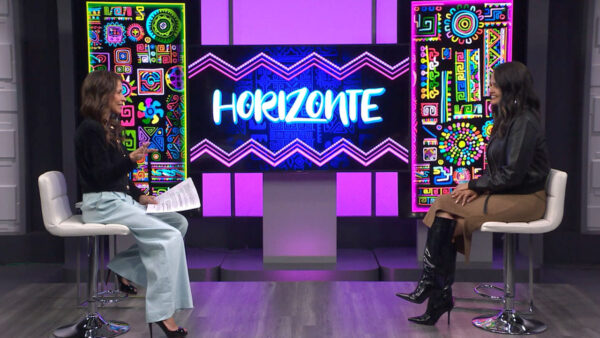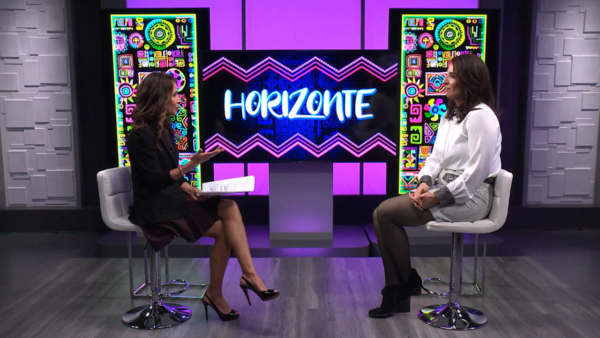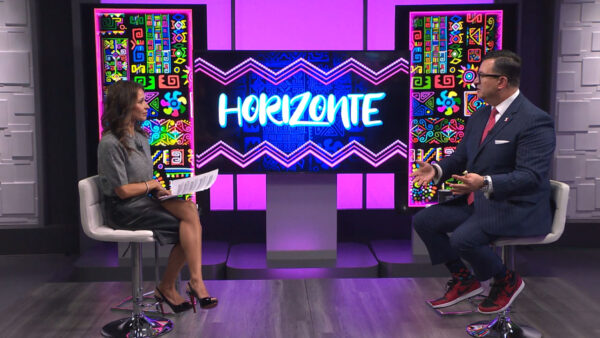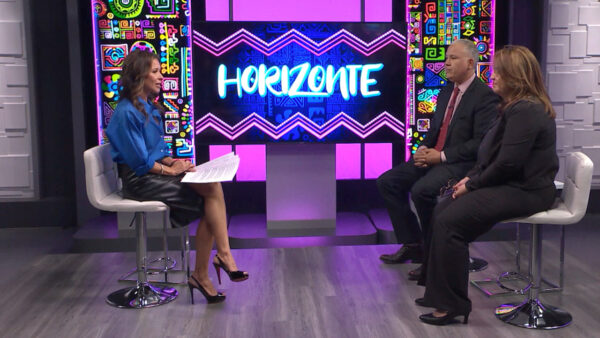Jim Ballinger, Phoenix Art Museum Director, and Dr. Vanessa Davidson, Curator of Latin American Art for the Phoenix Art Museum, discuss ‘Order, Chaos, and the Space Between: Contemporary Latin American Art from the Diana and Bruce Halle Collection,’ an exhibition featuring many of the most cutting edge contemporary works produced in Latin America today. Also, there are works from the post-war period drawn from the Halle Collection, internationally renowned as one of the most significant collections of art of this region.
Jose Cardenas: In SOC, sounds of cultura, contemporary Latin American art from the Diane and Bruce Halle collection, produced today in Latin America. Joining me to talk about the exhibition is Jim Ballinger, Phoenix art museum director, also Dr. Vanessa Davidson. Thank you for joining us. 9 Jim, let's start with you. Tell us how the collection came to be. We know the Halles are noted art collectors. How did it come to be they made the decision to do this exhibition?
Jim Ballinger: They have been involved in the museum for over two decades. In the mid-90s was looking to form a collection that could make a difference real here in Phoenix. In 1995, they bought their first work, and over the last 18 years, it's an exhibition that has grown into the hundreds of pieces. To have this exhibition with about 50 works of art by 40 artists carefully selected by Vanessa and the Halles's own curator is just an incredible opportunity to get a flavor of what's going on all over South America particularly and Mexico as well.
Jose Cardenas: this is consistent with what the museum has been doing in enhancing its focus in this area.
Jim Ballinger: As you know, Jose, from the very beginning the art museum has been involved with art of Mexico, has continued and expand wad we're doing. Vanessa is coming here with an endowed position as curator as part of this growth. We have done major exhibitions, the most recent Mexican modernism three years ago, which was a smash success here. I think this will be too. Here it's artists making a difference. Artists in the museum right now, one of the pieces we'll discuss tonight is being installed right in front of people's eyes as they walk into the lobby of the museum. It's a really great opportunity and it's also an effort of the Halles, some of the projects to bring ASU and the art museum together. There's a lot of commingling with the art department. We have even an arc texture professor at the university has created the primary design of the galleries for us. It's just a terrific opportunity. The museum will look in a way it has never looked before.
Jose Cardenas: Dr. Davidson, you come to us from New York where you had a very distinguished career. Tell us about that and what brought you to Phoenix.
Dr. Vanessa Davidson: Well, when I heard about this job opportunity, I looked into the Phoenix art museum's past and tried to imagine where it would go in the future. In 1957, two years before the museum was officially founded, there was an exhibition of Mexican modernist painting followed in 1968 by a retrospective. In '78 by a Carlos show, '84 Diego Rivera exhibition. I tried to see where they came from and where they might be going. In my conversation with the staff and Mr. Ballinger I realized there was so much room for expansion, for growth in this collection beyond Mexico. I think that since we are neighbors with Mexico we tend to focus our sights on just south of the border, but I think it would be a wonderful opportunity for us for our whole community of residents in Phoenix and greater valley to look further south. To look at Cuba, to look at the Dominican Republic. To look at Puerto Rico. To look to Brazil. That's one of the things this exhibition helps bring about. This is truly revolutionary I think in two ways. The first way is that the first time in the museum's history we'll have so many seminal works of art from such diverse countries as Brazil, Argentina, Colombia, Cuba, Peru, Ecuador -- Venezuela and Mexico under one roof. We'll be collecting these diverse works and showing them off to best effect in this exhibition. The second way it's revolutionary is it will help broaden our audiences "Horizon" beyond Mexico, create a space between, if you will, between what current perceptions of what Latin American art is and hopefully what they will gain from exhibition is a more nuanced understanding of how rich, diverse and complex the artistic manifestations from Latin American art actually are.
Jose Cardenas: A few words about your background and work in New York.
Dr. Vanessa Davidson: sure. I received my Ph.D. from the institute of fine arts, New York university. While living in New York I worked with the metropolitan museum on a colonial show called the colonial and December. Textiles and Silver work from 1530 to 1830. I gained a lot of experience working there for three years. I very nearly went the colonial route. Part of my attraction to this job in Phoenix was we also have a wonderful collection of colonial art. Which maybe perhaps people don't recognize up on the second floor in the gallery. I was very attracted to this museum and this collection because of its strength in both colonial and 20th century art.
Jose Cardenas: focusing on the contemporary art, we have about five photographs of pieces. The first one, a Brazilian artist.
Dr. Vanessa Davidson: the first artwork is by Antonio GIAZ. It was created in 1970, called the space between. It consists of a black granite cube with white docks and a white cube with black dots. The black cube there's the words the beginning. The white cube, the words the end. In this work he reminds us although everything in life has a beginning and end, it's the space between that counts. It evokes a continuous presence Atime and space in a latent state of becoming. In this way I think this works as a metaphor for the Halle collection, which continues to grow and evolve and expand in new directions.
Jose Cardenas: The next piece is I think the piece that Jim was talking about when he said people will have an opportunity to see before the exhibition opens actually it's being prepared now.
Dr. Vanessa Davidson: It's being prepared as we speak. It's called black cloud. It's by a Mexican artist named Carlos Morales. What's so intriguing about this artwork beyond its haunting beauty is it turns the technique of collage on its head. You associate it with paper upon paper or paper upon canvas, but what he has done here is turned the gallery space into a canvas for collage. What you see when you come to this work is what from afar is a hovering black cloud above the exhibition space. When we draw closer what you see are a series of surrealistic insects poised in sculptural formations on the wall. Each of the 30,000 paper moths and butterflies has been painstakingly pasted to the wall by hand.
Jose Cardenas: the next one you'll have the trouble keeping the school kids away from this one. We want people -- you want people to partake of this particular exhibition.
Jim Ballinger: 75 pounds of candy. The viewer is actually invited to take a piece of candy from that piece. I think it's about the temporal life we're in. You watch this thing kind of get smaller and smaller. It's also a metaphor for the artist partner who passed away. Had to do with the inception of some of this work with watching a life go from beginning to ends and comes back to the exact metaphor that Vanessa was talking about. This whole idea with the title of order and chaos, the space between, is a very almost literal interpretation for me of the polarity of Latin American art since World War II.
Jose Cardenas: We have two more pieces to get through quickly before we run out of time.
Dr. Vanessa Davidson: sure. Carlos is one of the protagonists -- in Venezuela. He really transformed color and light, effects of light, into his raw materials. It dates from 1965 to 2008 when they were refabricated are slats of plexiglas sheets of color. When you move around you look through these, you get a new perception of color. The colors co-mingle upon your retina and create a very interesting optical effect. As in most of the kinetic artwork from Venezuela the piece does not work, the speck at that timor make the work kinetic.
Jose Cardenas: this last one reflects some of the turmoil that's often engulfed various Latin American countries.
Dr. Vanessa Davidson: yes. He's Colombian. As we all know Colombia has gone through a terrible -- many decades of violence, civil war. What Salcedo has done in this work -- it's an untranslatable title but it comes from the Latin term -- in mourning and rage. What she has done in this work is to collect women's shoes who disappeared, and she has cut niches into the wall and sewn up this wound with a suture of surgical thread. With animal skins in front of them. Often when people went missing their bodies could be identified in mass graves only by the shoes they wore.
Jose Cardenas: We have information about the exhibition on the screen and a book that just came off the press.
Jim Ballinger: today. It's a series of articles documenting this exhibition. I was taken by leafing through it how accessible this work really is. To the kinetic idea, there's a lot of interactive going on, the scale of things, powerful color. I think are attractions to people that normally wouldn't be drawn to it.
Jose Cardenas: I'm sorry, we're out of time. Thank you both for being here. That's our show for tonight. I'm Jose Cardenas. Have a good night.
Jim Ballinger:Director, Phoenix Art Museum; Dr. Vanessa Davidson:Curator, Latin American Art for the Phoenix Art Museum;










